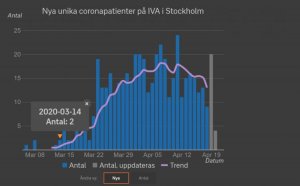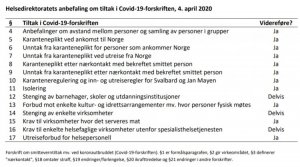ADVARSEL - FØLGENDE INNEHOLDER VIKTIG INFORMASJON OM SYKDOMSFORLØP MED KORONA. DENNE INFORMASJONEN KAN REDDE LIV, MEN ENKELTE VEGRER SEG OG MENER DET ER KRISEMAKSIMERING MED SLIK INFORMASJON. DISSE BØR HOPPE OVER INNLEGGET.
ADVARSEL SLUTT.
Det kan være av interesse å få vite at man kanskje ikke trenger så mange respiratorer som man tidligere antok, fordi man ikke forstod sykdommen.
Det må sørges for lett adgang til pulsoksimetere til befolkningen, slik at man tidlig kan finne dem som er på vei til å ødelegge lungene sine, på grunn av "stille hypoksi".
Widespread pulse oximetry screening for Covid pneumonia — whether people check themselves on home devices or go to clinics or doctors’ offices — could provide an early warning system for the kinds of breathing problems associated with Covid pneumonia.
En av USAs fremste eksperter på intubering av pasienter tilbrakte 10 dager på Bellevue sykehuset, for å forsøke å forstå hva som er beste prosedyre med koronapasienter. Staben har innsett at Covid-19 utvikler seg på måter som er helt nye og som gjør antakelser om fremgangsmåter ugyldige.
Samtlige som kommer til sykehuset har koronalungebetennelse i fremskredet stadium, men lider også av det de nå er begynt å kalle "stille hypoksi", altså alvorlig oksygenmangel, før de blir kortpustede.
And here is what really surprised us: These patients did not report any sensation of breathing problems, even though their chest X-rays showed diffuse pneumonia and their oxygen was below normal. How could this be?
We are just beginning to recognize that Covid pneumonia initially causes a form of oxygen deprivation we call “silent hypoxia” — “silent” because of its insidious, hard-to-detect nature.
Pneumonia is an infection of the lungs in which the air sacs fill with fluid or pus. Normally, patients develop chest discomfort, pain with breathing and other breathing problems. But when Covid pneumonia first strikes, patients don’t feel short of breath, even as their oxygen levels fall. And by the time they do, they have alarmingly low oxygen levels and moderate-to-severe pneumonia (as seen on chest X-rays). Normal oxygen saturation for most persons at sea level is 94 percent to 100 percent; Covid pneumonia patients I saw had oxygen saturations as low as 50 percent.
To my amazement, most patients I saw said they had been sick for a week or so with fever, cough, upset stomach and fatigue, but they only became short of breath the day they came to the hospital. Their pneumonia had clearly been going on for days, but by the time they felt they had to go to the hospital, they were often already in critical condition.
Ny innsikt om sykdomsforløpet forklarer hvorfor pasienter dør brått. Sykdommen har allerede gått for langt fordi man kommer for sent til kyndig hjelp. De første antakelsene om at man ville trenge et stort antall respiratorer var kanskje feil, sykdommen har nådd for langt da. Det man trenger er å identifisere dem som er på vei inn i "stille hypoksi", men som tror de bare har en forkjølelse eller mild influensa og som ikke legger merke til at de er begynt å puste fortere og har fått høyere puls (fordi kroppen forsøker å kompensere for oksygenmangelen).
Dersom dette identifiseres tidsnok kan man fange opp dem som er i ferd med å utvikle mer alvorlig sykdomsforløp på et stadium der nødvendig assistanse er langt enklere og mindre ressurskrevende.
A major reason this pandemic is straining our health system is the alarming severity of lung injury patients have when they arrive in emergency rooms. Covid-19 overwhelmingly kills through the lungs. And because so many patients are not going to the hospital until their pneumonia is already well advanced, many wind up on ventilators, causing shortages of the machines. And once on ventilators, many die.
Folk bør få enkel tilgang til et "pulsoksimeter":
There is a way we could identify more patients who have Covid pneumonia sooner and treat them more effectively — and it would not require waiting for a coronavirus test at a hospital or doctor’s office. It requires detecting silent hypoxia early through a common medical device that can be purchased without a prescription at most pharmacies: a pulse oximeter.
Pulse oximetry is no more complicated than using a thermometer. These small devices turn on with one button and are placed on a fingertip. In a few seconds, two numbers are displayed: oxygen saturation and pulse rate. Pulse oximeters are extremely reliable in detecting oxygenation problems and elevated heart rates.
https://www.nytimes.com/2020/04/20/opinion/coronavirus-testing-pneumonia.html?









